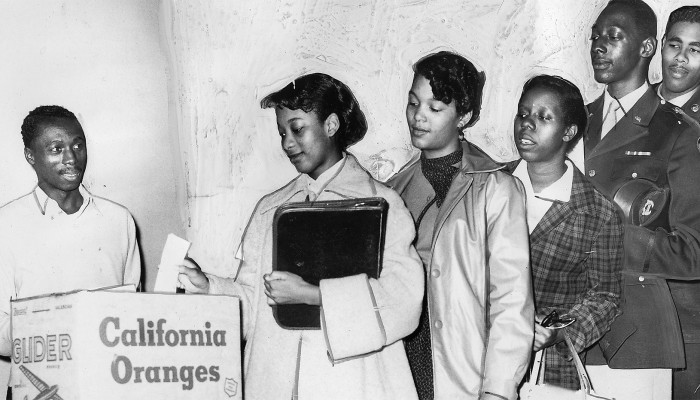Today marks the 150th anniversary of the ratification of the 15th Amendment, which was adopted to give Black people access to the ballot after the Civil War. The amendment has retained its promise but, unfortunately, the robust democracy that it envisioned remains just out of reach. Today, we should honor the life of the momentous amendment by remembering that the fight to keep it continues.
Case in point: the 1965 Voting Rights Act (VRA). Authorized by the 15th Amendment, the VRA is one of the most consequential laws ever enacted. It dismantled Jim Crow practices that severely restricted African-American access to the ballot, such as poll taxes and literacy tests. For some 50 years, it helped ensure that democracy reflected the country’s diversity.
That all changed with Shelby County v. Holder. The 2013 Supreme Court decision completed a decades long conservative effort to dismantle the VRA by gutting the section that required states with a history of voting discrimination to obtain federal approval before changing their voting laws. Chief Justice John Roberts, a longtime crusader against the VRA, wrote the majority opinion, in which he argued that the law undermined “the fundamental principle of equal sovereignty” among the states. He also highlighted the “‘dramatic’ progress” in minority voting over nearly five decades. In her prescient dissent, Justice Ruth Bader Ginsburg analogized the majority’s approach to “throwing away your umbrella in a rainstorm because you are not getting wet.”
Indeed, Americans got soaked. Immediately after the ruling, states across the country began to enact strict laws designed to make it more difficult for people of color to vote. Lawmakers have denied that their intent was to discriminate against minority voters, citing imaginary voter fraud as their chief justification. While we haven’t reverted to the level of discrimination seen in the Jim Crow-era, there have been consistent efforts to place obstacles between minority voters and the ballot box. And their impact is clear. When pivotal elections come down to a tiny fraction of votes cast in just a few states, any suppression can have election-altering consequences. It paints a bleak picture for our future.
Tragically, failure is nothing new to the 15th Amendment. One need only look to the amendment’s history — which, by its nature, is the story of African-American experience — to understand why. For nearly 250 years, “the peculiar institution” of slavery fed into the nation’s booming industries and facilitated its boundless growth. Even as the country prospered, enslaved people were denied the fruits of their own labor. They were also denied a voice in America’s fledgling democracy. This only began to change in the middle of the 19th century, as the abolitionist movement picked up steam and the United States split in two.
At the close of the Civil War, the nation wrangled with the future of nearly 4 million Black people who, until the adoption of the 13th Amendment, had been held captive in the South. On the heels of the 13th Amendment, which formally ended slavery, Congress passed the 14th Amendment to guarantee Black people citizenship and equality under the law. But suffrage was an entirely separate question. As lawmakers mapped out plans to reunify the country, extending the right to vote was hardly a priority in the North — even among staunch abolitionists.
In the South, however, Black people were voting. In some states — Louisiana, Mississippi, and South Carolina — the African-American electorate outnumbered its white counterpart. That’s because in 1867, Congress passed the Reconstruction Acts. The new laws established, among other things, conditions for the former Confederate states’ return to the Union. Perhaps the most important stipulation was that the readmitted states had to draft new constitutions that guaranteed suffrage to citizens regardless of their race. Meanwhile, many states in the North and West were voting down ballot measures to broaden the franchise in those regions.
But it didn’t take long for the Radical Republicans to recognize that for Reconstruction to have a chance, African Americans would have to be able advocate for themselves in elections. So in 1869, the lame-duck Congress passed the 15th Amendment over impassioned opposition. (Delaware Senator Willard Saulsbury, for example, called it an “exercise of absolute and tyrannical power.”) The amendment, which was ratified in less than a year, made it illegal to “deny” or “abridge” the right to vote “on account of race, color, or previous condition of servitude” and gave Congress the power to enforce the new law. Soon, Black people began voting not only in the South but throughout the country. They were elected to statewide office and were even sent to Washington to represent Americans in both houses of Congress.
However, in two key respects, the 15th Amendment came up short.
The first complication was sex. While the original Constitution was written by men and implicitly for men (e.g. “a President . . . shall hold his office during the term of four years”), that understanding was made explicit for the first time after the Civil War. With the adoption of the 14th Amendment, federal lawmakers were authorized to reduce the size of a state’s representation if it denied voting rights to any “male inhabitants” over 21 years old. In other words, the Constitution called on states to extend suffrage rights to men and men alone.
Less than a year later, when Congress proposed the 15th Amendment, its text banned discrimination in voting, but only based on “race, color, or previous condition of servitude.” Despite some valiant efforts by activists, “sex” was left out, reaffirming the fact that women lacked a constitutional right to vote. The omission prompted a schism in the woman suffrage movement. Some suffragists, like Lucretia Mott, accepted it as political reality and hailed the adoption of the amendment as a victory. Others, like Elizabeth Cady Stanton, were much less forgiving. They opposed the 15th Amendment, arguing — at times in strident racist rhetoric — that white women deserved voting rights before Black men.
Though it took another half century, white women eventually did win the right to vote. In 1920, when the states ratified the 19th Amendment, the Constitution finally outlawed sex discrimination in the franchise. Yet, with the recent resurgence of women’s activism, and in light of Virginia’s recent ratification of the Equal Rights Amendment, it’s worth pondering today whether these gains could have been realized sooner. At the same time, it’s important to understand that the 19th Amendment left Black women behind.
This is a consequence of the second failure related to the 15th Amendment: the country ignored it.
Reconstruction ended in 1876. From then until the 1960s, the majority of America’s Black population was prevented from voting, as states manufactured “legal” ways to suppress their registration and turnout without violating the 15th Amendment. For nearly a century, Jim Crow flourished in the South, where most African Americans lived. This only changed with the rise of civil rights movement, which achieved a string of historic victories that included the enactment of the VRA.
Within four years of the VRA’s enactment, Black voter registration rates had surged from 35 percent to 65 percent. But now, in the post-Shelby County era, the VRA is not enough to prevent disenfranchisement of African Americans and other people of color.
So on the sesquicentennial of the 15th Amendment, Americans should celebrate the incredible progress made since the country’s founding. But they should also reflect on the rocky route to that progress — and acknowledge that there’s much further to go.







